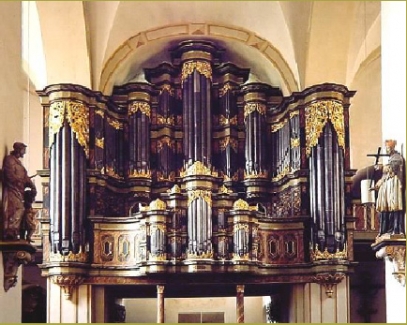


Marienmünster, ehem. Klosterkirche

Johann Patroclus Möller 1736-1738
State of preservation: Pipes largely original as well as the spring chest in BW. Restorations in 1921,1961-66 and 2010-12
The organ of Marienmünster is the biggest organ by Möller still existing and the biggest organ monument of the region.It has also a special place in organ restoration history, since during the first restoration in 1921 an important part of technical features, its original spring chest, was preserved, at a time when "restoration" only meant the preserving of sounding components, but modernising all parts of technique with the latest achievements of the time without any hesitations.But such alterations often demanded massive changes of the pipes themselves and their sound qualities. The insight in the decisive influences for sound of a technical setup considered obsolete in the 19th and early 20th centuries only grew with restorations like those in Marienmünster.
The organs of Westphalia show a remarkable union of differing ideals in the cutting zone of northern and central German and Dutch/Flemish organ landscapes of largely different religious denominations. This organ type of impressive monumentality bears only very few of the otherwise notable Italian influences in catholic regions. Möller's (and the regional-westphalian) style has some distinctive elements like the threefold Sequialtera or single stops of 1'. The organ architecture with pedal towers linked to the main organ giving an impressive semicircle shows northern German and Dutch influence but its tendency in width taking the complete gallery is in sharp contrast to the towering heigth of Dutch organs.
Specification:
III+P; manuals C,D –c3; pedal C,D-d1.
HW:
Principal 16’ (Möller)
Octav 8’ (Möller)
Viola di gamba 8’ (majority Möller)
Gemshorn 8’ (Möller)
Quinte 6’ (Möller)
Octav 4’ (Möller)
Duesflöte 4’ (Möller)
Gedackt 4’ (B; majority Möller)
Cornett 3f. (D; Möller)
Terz aus 4’ (1 3/5’) (majority Möller)
Sesquialtera 3f. (Möller)
Mixtur 2’ 5f. (majority Möller)
Zimbel 1’ 4f. (1966)
Trompete 8’ (Möller)
Vox humana 8’ (Möller)
RP:
Principal 8’ (Möller)
Gedackt 8’ (Möller)
Octav 4’ (Möller)
Rohrflöte 4’ (Möller)
Quinte 3’ (Möller)
Quintflöte 3’ (Möller)
Octav 2’ (Möller)
Waldflöte 1’ (majority Möller)
Sesquialtera (1 3/5’+1’) 2f. (Möller)
Mixtur 11/2’ 4f. (Möller)
Fagott 16’ (Möller)
Hautbois 8’ (Möller)
BW:
Quintadena 8’ (1966)
Traversflöte 4’ (1966)
Gedackt 4’ (Möller)
Octav 2’ (Möller)
Quinte 1 1/3’ (1966)
Flageolett 1 1/3’ (Möller)
Mixtur 1’ 3f. (Möller)
Krummhorn 8’ (majority Möller)
P:
Principal 16’ (Möller)
Subbaß 16’ (1966)
Octave 8’ (1966)
Nachthorn 4’ (Möller)
Mixtur 4’ 6f. (Möller)
Choralflöte 1’ (1966)
Posaune 16’ (Möller)
Trompete 8’ (Möller)
© Greifenberger Institut für Musikinstrumentenkunde | info@greifenberger-institut.de



